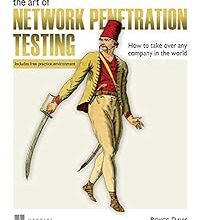The Web Application Hacker's Handbook: Finding and Exploiting Security Flaws
by Dafydd Stuttard, Marcus Pinto

The Web Application Hacker’s Handbook: Finding and Exploiting Security Flaws
by Dafydd Stuttard, Marcus Pinto
Rating: 4.5/5
In the vast sea of cybersecurity literature, The Web Application Hacker’s Handbook: Finding and Exploiting Security Flaws emerges as a beacon for those navigating the intricate waters of web application vulnerabilities. Written by the adept duo Dafydd Stuttard and Marcus Pinto, the book masterfully illuminates the depth and breadth of web application security, presenting it not merely as a subject of study but as an art form that’s continuously evolving.
From Basics to Brilliance
A cornerstone of this book’s brilliance is its scaffolded approach to knowledge. Starting with the fundamentals, it lays down a robust foundation, making it accessible for those new to the field. As one progresses, the content adeptly advances in complexity, ensuring that even seasoned professionals find nuggets of wisdom and new techniques to enhance their repertoire.
Practicality at its Finest
Theory without application can leave a learner in the dark. Recognizing this, the authors have woven a tapestry of real-world examples, walkthroughs, and hands-on scenarios throughout the text. These practical inclusions allow readers to transpose their theoretical insights into actionable knowledge, a feature indispensable for budding and experienced bug hunters alike.
Potential Drawbacks: Age and Density
No resource is without its limitations. While the book is a treasure trove of information, its dense nature can occasionally feel like traversing through a thicket for novices. The terminology and vastness of content, though enlightening, may require breaks and revisits to digest fully.
Furthermore, given its 2011 publication date, certain aspects of the content have aged. The rapid progression of technology and cyber threats means that some sections may not address the latest vulnerabilities or defense techniques. However, this doesn’t diminish the book’s core value; it simply calls for supplemental reading to stay abreast of the latest developments.
Comparative Analysis
When placed alongside other seminal works in cybersecurity, The Web Application Hacker’s Handbook holds its ground firmly. While other texts might delve into specific niches or remain strictly academic, this handbook strikes a balance, making it a versatile tool in a cybersecurity enthusiast’s arsenal.
Conclusion
The Web Application Hacker’s Handbook: Finding and Exploiting Security Flaws stands tall as an essential guide in the ever-evolving realm of web security. It’s a testament to the authors’ expertise and their commitment to equipping readers with a holistic understanding of web application vulnerabilities. Though it has minor shortcomings in terms of its age and information density, its foundational strength, practical examples, and comprehensive coverage make it a must-read. Whether you’re a neophyte looking to get your feet wet or a veteran seeking to refine your skills, this book promises a journey of discovery and mastery in web application security.




